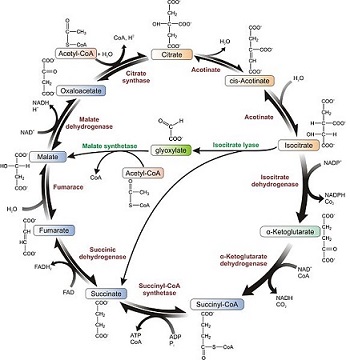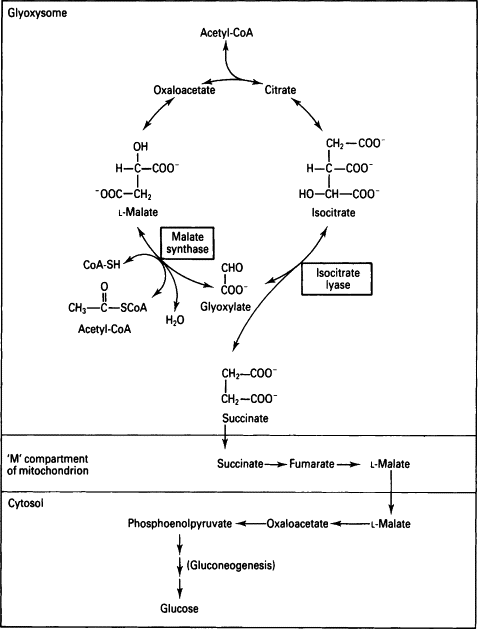
- In plants, certain invertebrates and some microorganisms (including E. coli and yeast), acetate can serve both as an energy-rich fuel and as a source of phosphoenolpyruvate for carbohydrate synthesis.
- These organisms are equipped with the metabolic machinery called the glyoxylate cycle to convert fats into carbohydrates.
- Hans Kornberg and Neil Madsen elucidated this pathway in the laboratory of Hans Krebs.
- The enzymes of the gyloxylate cycle catalyze the net conversion of acetate to succinate or other four carbon intermediates of the citric acid cycle.
- If a cell cannot convert acetate into phosphoenolpyruvate, acetate (derived from fatty acids and certain amino acids) cannot serve as the starting material for the gluconeogenic pathway, which leads from phosphoenolpyruvate to glucose.
- Vertebrates (including man) cannot convert fatty acids, or the acetate derived from them, to carbohydrates since they lack enzymes of the glyoxylate cycle.
Steps involved:
- Glyoxylate cycle is regarded as an anabolic variant of citric acid cycle.
- It has two unique enzymes; isocitrate lyase and malate synthase which bypass some of the reactions of TCA cycle.
- The glyoxylate cycle involves the following steps:

Image Credit:
https://www.sciencedirect.com/topics/biochemistry-genetics-and-molecular-biology/glyoxylate-cycle
- Condensation of acetyl-CoA with oxaloacetate to form citrate:
- Acetyl-CoA produced either from acetate or by β-oxidation of fatty acids enters into TCA cycle and is condensed with oxaloacetate to form citrate.
- Isomerization of citrate to isocitrate:
- Citrate is isomerized to isocitrate in TCA cycle.
- Cleavage of isocitrate to from succinate and glyoxylate:
- This is the bypass reaction of TCA cycle.
- Unlike the breakdown of isocitrate by isocitrate dehydrogenase in TCA cycle, here, isocitrate is cleaved by isocitrate lyase to form succinate and glyoxylate.
- Condensation of glyoxylate with acetyl-CoA to yield malate:
- Succinate is further metabolized by TCA cycle.
- Glyoxylate then condenses with a second molecule of acetyl-CoA to form malate catalyzed by malate synthase.
- Oxidation of malate to form oxaloacetate:
- Malate is oxidized subsequently to oxaloacetate by the enzyme malate dehydrogenase.
- Oxaloacetate then starts another turn of the cycle.
*Two molecules of acetyl-CoA enter into each glyoxylate cycle and produce one molecule of succinate, which is then available for biosynthetic purposes.
Significance of glyoxylate cycle:
- It is a bypass reaction of TCA cycle.
- Oxaloacetate formed in this pathway can be used to synthesize glucose via gluconeogenesis.
- It occurs in bacteria when they are cultured in acetate rich carbon source (acetate being the sole source of carbon).
- This pathway is very significant in germinating seeds where the stored triacylglycerols (fat) is converted into sugars to meet the energy needs.
- When higher fatty acids are oxidized into acetyl-CoA without forming pyruvates, then acetyl-CoA enters into glyoxylate cycle.
Coordinated regulation of glyoxylate and TCA cycles:
- Regulation of isocitrate dehydrogenase activity determines the partitioning of isocitrate between the glyoxylate and citric acid cycles.
- When the enzyme is inactivated by phosphorylation (by a specific protein kinase), isocitrate into biosynthetic reactions via glyoxylate cycle.
- When the enzyme is activated by dephosphorylation (by a specific phosphatase), isocitrate enters the TCA cycle and ATP is produced.
The Glyoxylate Cycle (Steps involved, Significance and Regulation)
References:
- Lehninger, A. L., Nelson, D. L., & Cox, M. M. (2000). Lehninger principles of biochemistry. New York: Worth Publishers